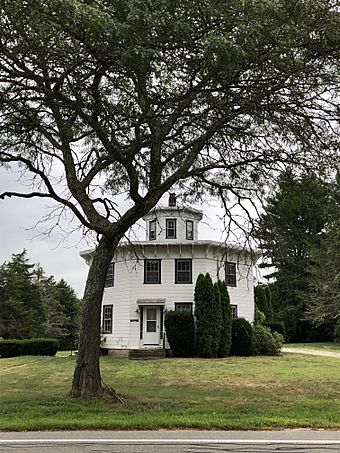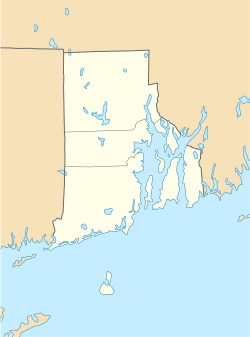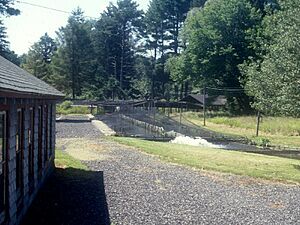Carolina, Rhode Island facts for kids
Quick facts for kids |
|
|
Carolina Village Historic District
|
|

Albert S. Potter Octagon House (1867)
|
|
| Location | Charlestown and Richmond, Rhode Island |
|---|---|
| Architectural style | Greek Revival, Italianate, Queen Anne |
| NRHP reference No. | 74000009 |
| Added to NRHP | May 2, 1974 |
Carolina is a small village in Rhode Island, USA. It sits right on the border between the towns of Charlestown and Richmond. The Pawcatuck River flows through the village. About 970 people lived here in 2010.
Contents
Discover Carolina Village
The Carolina Village Historic District is a special area. It was added to the National Register of Historic Places in 1974. This means its old buildings and history are important. The district covers 115 acres. It includes 71 properties, like an old mill and many homes.
You can see different styles of old buildings here. Some are Greek Revival. Others are Italianate or Queen Anne style. These buildings are found along Carolina Main Street and Carolina Back Road. You can also find them on smaller streets nearby.
A Look Back: Carolina's Story
Early Days and the Mill
The story of Carolina began in 1802. A wooden dam and a gristmill were built on the river. At first, the area was called Nichols Bridge. A few years later, a cotton mill opened. Most of its buildings were in Richmond. Some homes for workers were across the river in Charlestown.
In 1843, Rowland G. Hazard bought the mill. He renamed it the Carolina Mills Company. This was to honor his wife, Caroline Newbold Hazard. The village around the mill also took the name Carolina. In the 1800s, Carolina was a busy place. It had a school, a church, a post office, and several stores. There was also a bank and a blacksmith shop.
Changes and New Industries
In 1862, the mill stopped making cotton. It started making woolens instead. The Hazard family ran the mill until 1863. After that, other companies leased or bought it. The mill complex kept working until the early 1930s.
After the mill closed, Carolina became a quiet residential area. But many of its historic buildings remained. The village was listed on the National Register in 1974. In Richmond, you can see about two dozen old cottages. These were built between 1840 and 1870.
Other important buildings include the old mill remains. The Carolina School was built in 1845. The Carolina Free Will Baptist Church was also built in 1845. It was moved to a new spot in 1865. The unique, eight-sided Albert Potter House was built in 1867. There is also a large Queen Anne style house. It belonged to Ellison Tinkham, who owned the mills for many years.
Carolina was also home to one of America's first trout farms. John W. Hoxie started the Clearwater Trout Farm in 1877. His brother Charles opened the White Brook Trout Hatchery nearby. By 1892, Charles's hatchery became the American Fish Culture Company. The Hazard family later owned both farms. They merged them into the American Fish Culture Company. This company was sold to the State of Rhode Island in 1995. By the 1920s, it was the largest fish farm in America.
Carolina Today
Geography and Location
Carolina is a census-designated place (CDP). This means it's an area identified by the census bureau. It covers about 2.48 square miles. Most of this area is land. A small part is water. Carolina has its own zip code, 02812. The post office building is in Charlestown. But it serves only the Richmond side of the village.
Population Facts
In 2020, 924 people lived in Carolina. There were 382 households. About 19.3% of the people were under 18 years old. About 23.2% were 65 or older. The average age in Carolina was 48.4 years.
See also
 In Spanish: Carolina (Rhode Island) para niños
In Spanish: Carolina (Rhode Island) para niños




